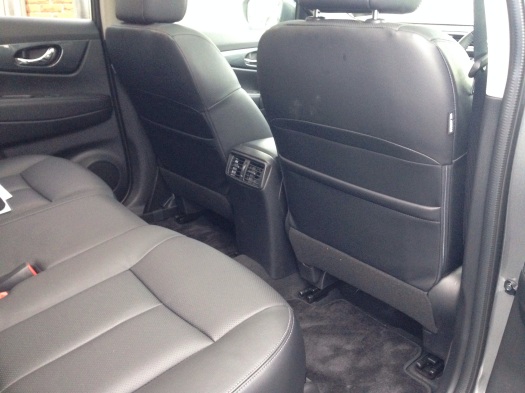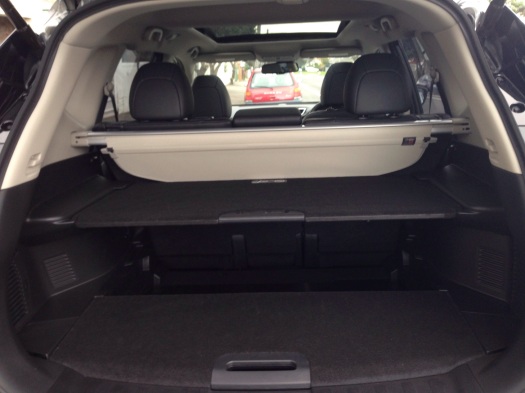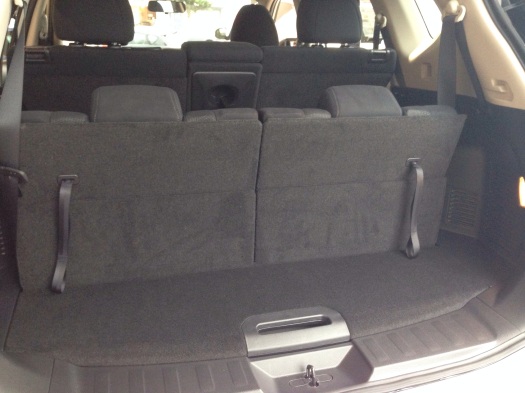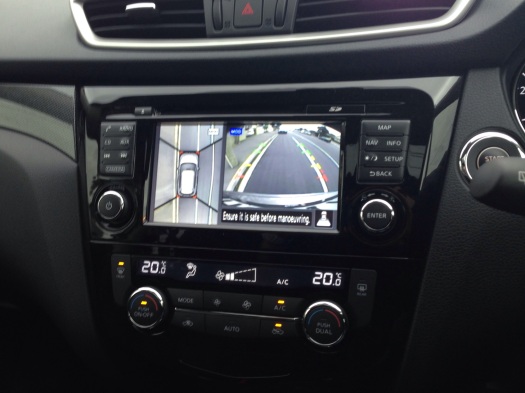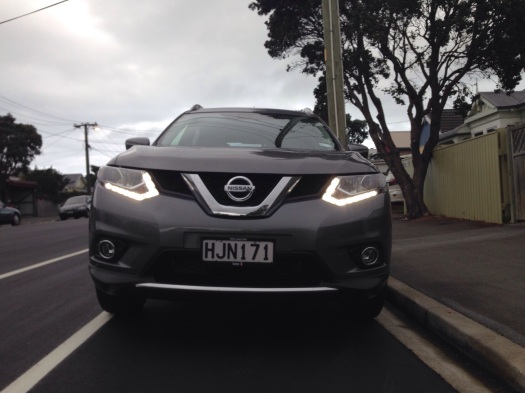2014 Nissan X-Trail 2.5 Ti 4WD review
It could be argued that today’s world has reached a point where political correctness has gone absolutely mad. If you haven’t heard, recently an often outspoken figure in the motoring press has been at the centre of a controversial storm. Some have accused him of being ‘racist’ for mumbling a particular word in a nursery rhyme and some have gathered a lynch mob outside his home calling for his head on a spike. Has the world gone mad? Are we really at a point in civilisation where we’ve been so sheltered that the slightest detraction from the ‘social norm’ must result in ending a man’s life? This is the witch trials all over again.
I won’t get in too deep about this because I’ll be here all day. But this whole political correctness gone mad does bring me on to the new Nissan X-Trail, weirdly. The first generation X-Trail was launched way back in 2001. That was the one that had a rugged boxy look. It was replaced by a second generation in 2007 which also sported a rugged boxy look and offered something different to other crossovers. The first two X-Trails also offered more capable off-roadability compared to its more road-orientated rivals. As a result the first two generation X-Trails were hits. It was function beating form.
This third generation of the X-Trail has gone through an ‘x-treme’ makeover and now follows the hegemonic styling of this class. In the world of crossovers, the new X-Trail is politically correct. Gone are the old rugged looks and in is a sleeker and sportier design. It’s a good looking thing. The prominent Nissan grille gives it a macho presence and the daytime running lights grabs people’s attention. The side is nice and sculpted without looking too fussy. The rear of it has drawn comparisons to the second-generation Lexus RX. Admittedly, they do look similar but that should be seen as a compliment. The styling follows on from Nissan’s latest SUVs and is a mix of Juke, Murano and Pathfinder. However its the new Qashqai that it resembles most. Which is no coincidence as while not only replacing the previous X-Trail, this also takes the role of being a 7-seat option for those wanting a bit more practicality from their mid-sized crossovers.
And people want crossovers. Everyone likes to think they want to save the world and buy a Prius or a Golf or something in in fact they want a high-riding SUV or crossover of some sort. Case in point my test drive of the X-Trail was shorter than my other test drives as people were lined up to take it out for a spin.
I understand the appeal of an SUV completely. It’s been a while since I drove an SUV but when I climbed into the X-Trail and got myself comfortable in its high driving position I have to admit it felt good. There’s a strange ‘feel good’ sensation sitting higher up than other motorists be it in a Nissan X-Trail or in a supercharged Range Rover.
Read into that what you will but there’s no denying the upside to visibility. You get a better view out of the road ahead which means you have time to change your driving style to suit conditions ahead. Which makes SUVs all the safer for families.
That’s crucial. Keep in mind that its families that’ll be buying these sorts of cars, not Sebastian Vettel. So if you approach it with that sort of mindset you’ll be quite impressed at how the X-Trail drives. There’s very little body roll and the 4WD version I drove felt very surefooted and safe. 4WD X-Trails come with an ALL MODE 4×4 i-system control dial which allows you to switch from 2WD to 4WD.
In 2WD mode it felt like a normal car with decent steering though feel and feedback were a bit diluted. It could be because the roads were wet. In 4WD the steering felt heavier. It could just be how the electrically assisted steering was set up. Around corners the X-Trail comes with a few techy bits to keep in check. As if 4WD grip wasn’t enough it comes with something called ‘Active Trace Control’ which uses many clever electronic brains to monitor speed, steering angle and throttle to brake the necessary wheels to avoid understeer. Then there’s Active Engine Break to help it stop faster. Clever stuff. Really only the inconsistent steering feel lets it down but even that won’t be a concern for most buyers.
What might concern some is the lack of a 4WD option for the 7-seater X-Trail. At the moment only the 7-Seater is only available in base ST trim. All 5-seater X-Trails from the ST all the way up to the Ti come with 4WD as standard.
So its a decent handling thing and doesn’t roll about in corners. But what about the ride? Well I’m happy to report that’s where the X-Trail shines. Its a smooth riding thing and absorbs all the bumps and bruises Wellington’s roads had to offer. Certainly you needn’t worry about your children getting sick on the lovely leather seats. The good ride is partly thanks to the new Renault-Nissan Common Module Family (CMF) platform that’s also shared with the new Qashqai. The Active Ride Control is also responsible. This system monitors road surfaces ahead to detect any imperfections and adjusts the dampers accordingly. It’s all very clever.
Another plus point for SUVs and the sort is the amount of space they have inside. I don’t know how but Nissan seems to have incorporated TARDIS technology with the X-Trail because there’s acres of space inside. Though, that could have something to do with this new X-Trail being bigger than its predecessor in every way. Up front mum and dad will get comfy easily as the electric seats offer infinite adjustment. In the back adults will have room to spare and kids will probably get lost. If you need more room the backseats slide backwards and forwards too.
Opt for the 7-seater and you get two seats in the boot. Note that these are for occasional use only. I managed to squeeze myself in the third row and had decent headroom but my legs needed amputating. It also eats up quite a lot of the generous boot space. If you need 7-seats all of the time then the bigger Pathfinder might be a better choice.
I like that about the X-Trail though because apart from the Outlander and the avoid-at-all-cost Craptiva, this is the only one in this segment that offers 7-seats. For most something like a Pathfinder or even a Santa Fe might be too big. The X-Trail is the right size and the availability of a 7-seat option opens it up to a wider audience.
The interior of the X-Trail is an even bigger leap from the old model than the exterior. The quality is top notch, almost European actually. Everything you see and touch looks and feels like it was designed to be as durable as it is stylish. It’s a good design that doesn’t offend the eyes. The amount of tech and equipment inside is nicely hidden behind a touchscreen veil. It’s a good system to use. The user interface is easy to comprehend and commands are quick. This is an interior befitting a circa-$50k car for sure.
Typical of a Japanese car, the equipment levels are generous. The top-spec Ti comes with nice little touches usually found in cars from the West. You get LED head and taillights, rain sensing wipers, a panoramic sunroof, electric tailgate and passive safety aids such as Blind Spot Warning, Lane Departure Warning and Moving Object Detection. The standard fit reversing camera and the Around View Monitor makes parking this 4656mm long SUV a breeze. I found rearward visibility pretty good anyway and the C-Pillar wasn’t as obtrusive as other cars thanks to a small but handy rear quarter light and large wing mirrors.
Performance wise the X-Trail is pretty good. It only comes with a 2.5-litre four cylinder which pumps out 171 bhp and 226NM of torque. This means a 0-100 kph time of a smidgen under 9 seconds. It’s a good engine being responsive and punchy when needed. What it doesn’t like doing is to rev though. Its not the most aurally pleasing engine out there. Keep it below 4000 rpm and its a refined contender. That reinforces that this isn’t the sportiest of the sports utility vehicle. A diesel might suit it however, Nissan being Japanese, favours petrol and hybrid.
Another thing Japanese firms seem to like is CVT gearboxes. I’ll come straight out with it that I’m not a fan of CVTs. It’s a personal thing, I just don’t trust pulleys and belts nearly as much as I trust cogs. That said the CVT in the X-Trail was smooth when left in auto and in tiptronic mode it made a convincing attempt at feeling like a conventional auto.
The plus side to a constantly variable transmission though is the fuel consumption benefits. Because its constantly trying to find the best gear it uses a decent amount of fuel compared to others in this class. Nissan claims 8.3L/100km. Certainly in Eco mode I can see it coming close to those figures. If you want less litre for your 100 kilometre then the possible hybrid might be for you. The lack of diesel option might put some off.
Prices for the X-Trail in New Zealand start from $39,990 for the 7-seater in ST trim. That’s remarkable value and comes with pretty much everything you need such as a reversing camera, daytime running lights, 8 airbags, multiple safety acronyms and an audio system that’s bluetooth and iPod compatible. The 5-seater ST with 4WD starts from $42,990. Step up to $47,290 ST-L and you get leathery bits, a 7″ LCD touchscreen, Around View Monitor and electric heated seats up front. The top spec Ti trim comes with European-levels of tech and starts from $53,290. Whichever way you look at it, it’s priced very well. It’s on par with the Ford Kuga, Hyundai iX35 and Toyota RAV4 and undercuts the Mazda CX-5, Volkswagen Tiguan and Honda CRV. All of which aren’t available with an extra row of seats.
The X-Trail all in all is a very good family vehicle. It ticks all the right boxes; it looks good; has a nice interior; decent to drive; rides well; has decent fuel economy; and comes with as much space as it does gadgets. Priced competitively it’ll give SUV buyers a harder time deciding on which one to pick. But perhaps if Nissan had kept it rugged like the previous two generations it would be an easier choice for some.
I’m sure a minority will miss the option of having a mid-sized SUV that’s capable off road but truth be told most SUV and crossover buyers rarely take their cars off asphalt. Nissan knows this hence the shift in direction of the X-Trail and Pathfinder. Some might see this change as a bad thing, that this segment that’s getting more crowded by the day is so competitive everyone has ended up making essentially the same vehicle. That consumers have no choice. SUV political correctness gone mad? Perhaps, but there’s no doubt Nissan’s new and improved X-Trail will appeal to many.
Verdict: 8/10
Pros: Styling, on road manners, interior (design, quality and space), 7 seat option, good spec levels, competitive prices
Cons: No 4WD or top spec trim for the 7 seater, lack of diesel might put some off, not as rugged as previous X-Trails
Nissan’s shift of direction for the X-Trail makes it a strong contender in a crowded marketplace and broadens its appeal. Good thing it comes with 7 seats then.





